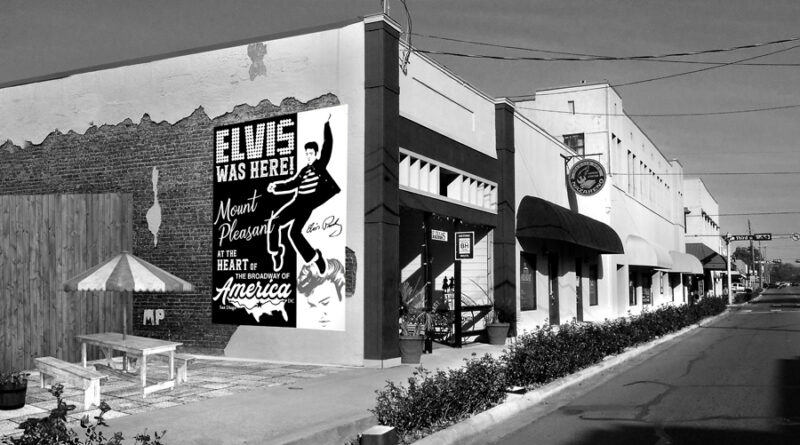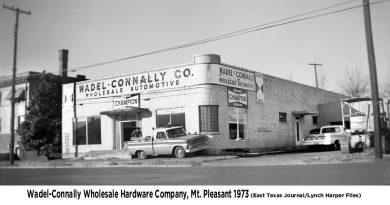Historian Traces Elvis to Mt. Pleasant performance in December, 1954
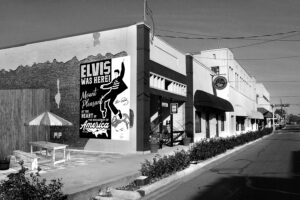
Reissued story from East Texas Journal December, 2015.
In a 1996 Journal interview tracked down in 2006 by a dogged historian trailing Elvis through Texas, Mt. Pleasant’s Jack Blackburn told of being a National Guardsman working the door the night the performer destined to become The King of Rock and Roll played the American Legion Hall. Fewer than 60 people came and Elvis was driving “an old car with his name on the side,” Mr. Blackburn said.
Rex Amerson saw the show and remembered Elvis arriving in a pink Cadillac.
“The car he was driving is important because we have different time frames for the cars he drove during the first 18 months he went on the road,” said Ernst Jorgensen, a Danish music producer and historian credited with legitimizing the King’s legacy.
It was four years after Mr. Jorgensen trailed an Elvis legend to the door of the Journal that Los Angeles Times reporter Randy Lewis reported on the validity of the researcher who’d tracked down Mt. Pleasant as the location of one of ten “missing” Texas performances.
“Expectations at RCA Records couldn’t have been much lower 20 years ago when a Danish record executive suggested putting together a box set exclusively of 1950s recordings by one of the label’s artists who had been dead for more than a decade.” Mr. Lewis wrote.
“Even though the artist in question happened to be Elvis Presley, there was little hope that a significant number of people would have much interest in a set encompassing five hours of music and 140 songs — only a small percentage of which had been hits — from just the first seven years of Presley’s recording career.”
Since the mid 1980’s, Mr. Jorgensen has researched record company archives, the job he got when he found himself working for BMG, a German firm that had acquired RCA records.
“I asked why we were treating the Elvis catalog so poorly,” he told the Journal, recalling 1991, the year BMG grew weary of RCA’s sluggish marketing and appointed Mr. Jorgensen to run the Elvis re-issue program.
“RCA officials cautiously issued the ‘Elvis Presley: The King of Rock ‘n’ Roll’ package, carrying a list price of $80, hoping it might sell as many as 10,000 copies,” Mr. Lewis wrote after the Los Angeles paper picked up on the story of Mr. Jorgensen’s proving up the Elvis market.
Citing the sale of over a million copies of the boxed set, Mr. Lewis wrote of “the executive from Denmark and music historian who is widely considered the most important figure in restoring not only a sense of order but also respectability to the recorded legacy of a music icon who, in the years after his death, was more often ridiculed than revered.”
It was after publishing “Elvis Presley: A Life in Music, The Complete Recording Sessions” that Mr. Jorgensen began researching an “18-month window” opening in 1954 when Elvis quit his job driving a truck for Crown Electronic in Memphis to go on the road.
Mr. Jorgensen’s East Texas lead was a scrap of paper, a note hand written by Bob Neal, Elvis’s first manager.
“March 14, 1955, Naples, Texas,” it said. “March 15, Omaha canceled.”
It was an interview with Naples Monitor Publisher Morris Craig that sent Mr. Jorgensen into the Journal archives where he found early KIMP radio personality Jesse Pate’s 1996 story about promoting Elvis’s Mt. Pleasant appearance.
In the early 1950’s Mr. Pate created the Cornbread Jubilee, a live broadcast first featuring local musicians as a musical-show backdrop for pitching Tate’s Elixir.
“I grew up seeing live patent medicine shows on the town square,” Mr. Pate said. “There was always some sort of performance. I wanted to be on the radio so bad I bought air time and booked the musicians I knew for entertainment.”
Response was instant. He spoke of piles of mail, not just orders, but fan mail. In the years that followed he became a promoter, booking musicians and playing station host for strings of performers who made Mt. Pleasant a musical landmark between Dallas and Shreveport. Stars buttered him up to get him to play their records.
In the days of live radio Slim Whitman, Kitty Wells, Hank Snow, Hank Williams, Red Sovine, the Wilburn Brothers – Mr. Pate and KIMP lured them here. Add Elvis to that play list, Mr. Pate said, recalling a day he drove the county with the singer, putting up flyers and advertising the show.
“He was just a kid, but everywhere we stopped, people loved him,” Mr. Pate said.
Within days of the Journal account of Mr. Jorgensen’s effort to validate and date the Mt. Pleasant show, memories were pouring in.
Gary Max Bragg remembered the show as being the summer of 1954.
“He was here with Jim Ed, Bonnie and Maxine Brown,” Mr. Bragg said. “There wasn’t but one bathroom in the American Legion Hall and the girls were using it for their dressing room. I walked over to the gas station across the street and saw a guy wearing a rust colored suit standing in front of the mirror, combing his hair. He followed me out on the curb and we started talking and he introduced himself. It was Elvis. We got a coke and visited.”
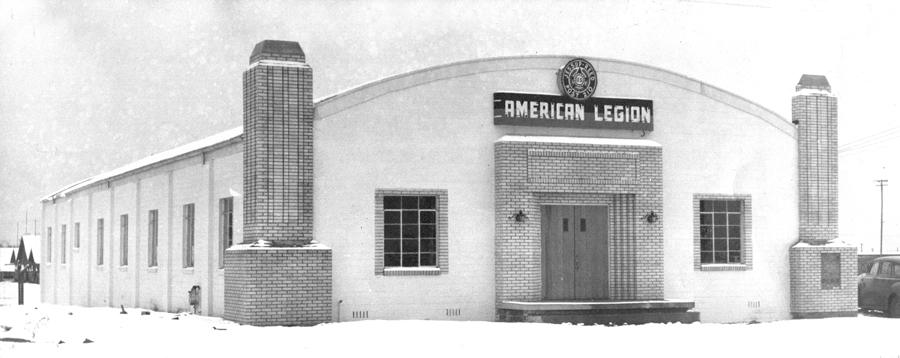
The singing Brown family fit; early on, Elvis and the Browns sometimes played the same shows, Mr. Jorgensen said.
Shirley Jean Caraway remembered Elvis coming out to sign autographs at intermission.“
A girl named Gail was a car hop across the street at Shirley’s Drive In,” she said. “They had outside speakers for the juke box. Since she couldn’t get off to see him, every time somebody gave her money to play the juke box she played Elvis. While he was out there signing autographs, he could hear himself on the juke box across the street.”
While the details in Mr. Bragg’s recollection coupled with Jesse Pate’s memory of putting up posters lent credence to the Mt. Pleasant story, the summer of 1954 didn’t fit since it was November before Elvis went on the road.
Further muddying the water, the conflict between accounts of his arriving in a pink Caddy and an older car with his name on the door provided two different time frames. Elvis had left Memphis in the winter of 1954 in a cream colored Chevy.
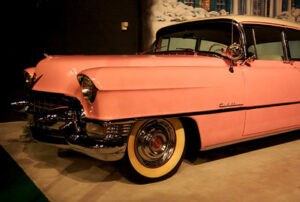
He got his first pink Cadillac in the spring of 1955, Mr. Jorgensen said.
The old car account provided by the Guardsman who worked the door fit with the time frame provided by a soldier remembering when he left the service.“
I got out of the army in September of 1954, went to work at Sandlin Motors in October and left in January,” Roland Bridges said. Sandlin Motors is still directly across the street from the location of the American Legion Hall in 1954.
“I was still working at Sandlin when I went to the show,” Mr. Bridges said.
“Bingo!” Mr. Jorgensen shot back in an email response after Nancy Holcomb provided an entry from her diary.
“I can tell you exactly when Elvis performed in Mt. Pleasant,” she said. “I didn’t go to the show because I’d never heard of him. Gary Bragg was a neighbor and the next day he told me what I’d missed. The next weekend I talked my parents into taking me to Shreveport to see him there.”
Her diary said Elvis played Mt. Pleasant December 3, 1954 and she saw him in Shreveport on December 11.
“Spot on!” Mr. Jorgensen responded, “mystery solved. Her December 11 Shreveport date hits a documented show. December 3 hits one of fewer than 10 open dates in the 18 months after he left Memphis. Another interesting thing, this makes Mt. Pleasant one of his earliest Texas shows. The first was the week before in Gladewater.”

